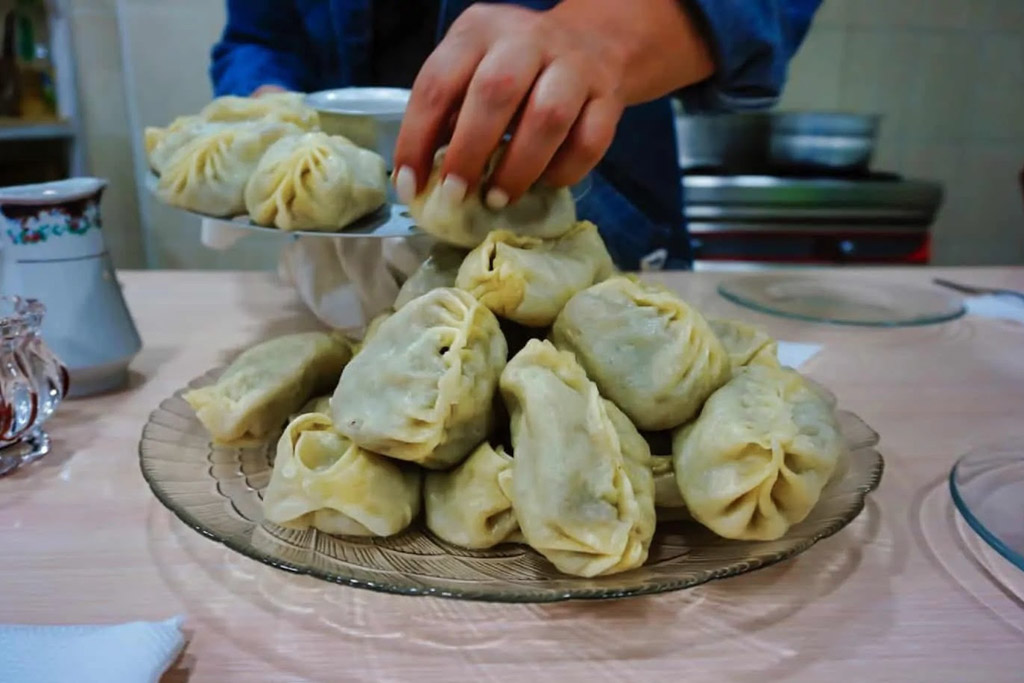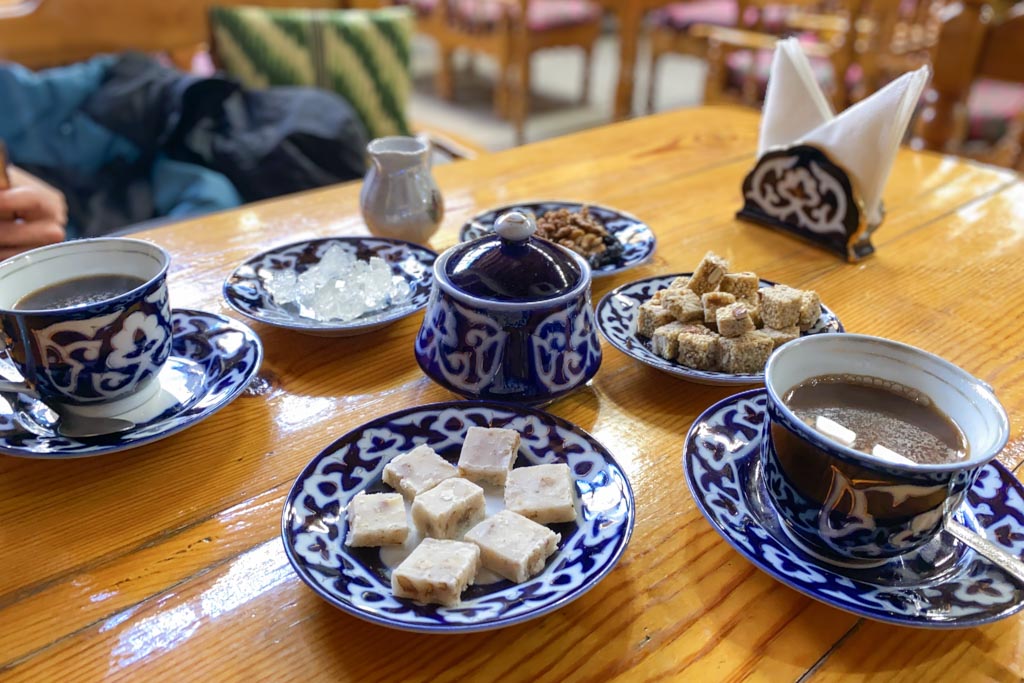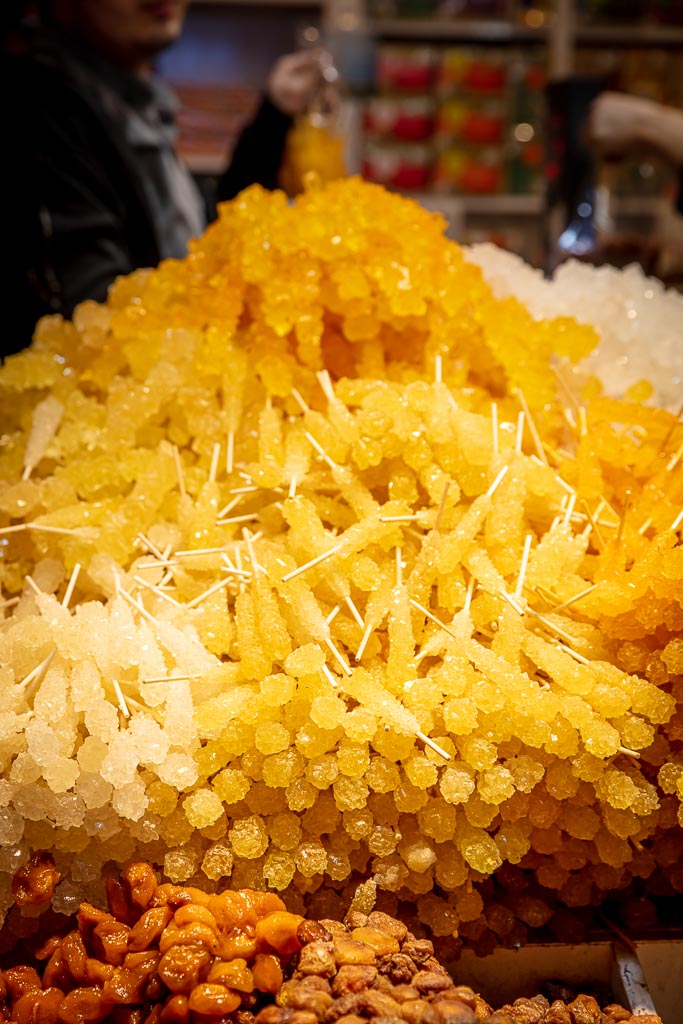Uzbek Food: 33 Must-Try Dishes in Uzbekistan
Uzbek Food: 33 Must-Try Dishes in Uzbekistan was originally published in March 2023
When most think of Uzbekistan they conjure up visions of the famous architecture of Samarkand, Bukhara, and Khiva or Amir Timur’s conquests and the Silk Road fortifications that dot its desert landscape. But one major highlight of a visit to the country that is often glossed over is trying all the delicious Uzbek food as you traverse the country from east to west.
I had an idea of what Uzbek cuisine was going to be like the first time I arrived in Uzbekistan as it was part of a greater Central Asia trip taking in Tajikistan, Kyrgyzstan, and Kazakhstan before I reached Uzbekistan’s border at Andijon. While Tajikistan had great food as well as its neighbors, I had to say that many of the dishes I found on that first trip to Uzbekistan were a bit more vibrant.
Sure you can find pretty bland renditions as you travel every corner of the country (the same, of course, could be said about pretty much any country), but in general, Uzbek food is quite tasty, drawing in influences from other parts of Central Asia, the Middle East, China, Afghanistan, Russia, and beyond.
Uzbek food can generally be quite meat-centric, but not to despair for vegetarians planning a trip to Uzbekistan out there. Salads are quite common and people are becoming more and more familiar with vegetarian visitors so many times you can ask for dishes in restaurants go’shtsiz/бе гушт/без мяса (without meat).
So as you traverse the Silk Road routes that form a web across Uzbekistan, make sure and enjoy heaping plates of regional Uzbek foods that make the cuisine in this nation special. If you’re wondering what Uzbek foods to try on your upcoming trip, look no further! Here are 33 Uzbek dishes to try on your visit to Uzbekistan.
Main Courses
Plov

If one did not plov, were they really in Uzbekistan? The ubiquitous rice dish is impossible to avoid whilst traveling Uzbekistan be it called plov, pilaf, osh, etc. Every region and most cities even boast a unique variation of the dish.
At its core, plov consists of rice fried in a qazan (a big metal wok popular in Central Asia), onions, carrots, and meat (usually beef), but there are a myriad of added accouterments that can dress a plov and make it unique to a destination.
Likely characters you’ll encounter are Samarkand plov, with qazi (slices of horse sausage), chickpeas, yellow carrots, and a quail egg; bakhsh, a Bukharan Jewish rendition of a brownish-green color, made with cilantro leaves and chunks of lamb (or sometimes chicken) that is then all placed in a bag and submerged in boiling water; Fergana plov which features spicy chilis; or Tashkent plov which requires all its ingredients to be roasted before cooking the dish together.
Plov is without a doubt one Uzbek food you must try while traveling in the country as it is widely considered to be the national dish. If you will be beginning your Uzbekistan trip in Tashkent, I recommend heading to Besh Qozon (formerly the Central Asian Plov Center) to see plov being made in ginormous qazans and to dig into your first plate of plov.
Shashlik

Shashlik is one of my favorite meals in Uzbekistan as well as the Central Asia region and a simple one consisting of grilled skewered meats. Typically shashlik is cooked outside over a narrow metal grill- just follow the smell of barbecue being fanned toward you and the sizzle of vinegar dousing the meat and hitting the coals.
Shashlik can be found in a few varieties including cubed chicken, beef, lamb, and my favorite, farsh- a ground/crushed beef (sometimes beef/lamb mixture). The name shashlik is derived from Persian where in Farsi it’s pronounced shish-leek, meaning “six pieces”.
And not to fear vegetarians, many restaurants serving shashlik will make vegetable shashlik on request- expect tomatoes, onion, bell peppers, and sometimes potatoes, eggplant, and even carrot.
Lagman

Lagman is my all-time favorite Central Asian dish. Its roots are from Xinjiang– where the dish originated and was brought to Uzbekistan and the greater Central Asian region by the Uyghur people who fled through the Tien Shan Mountains to escape persecution by the Chinese government (full disclosure, it’s said that Uyghur lagman is an adaptation of noodle dishes originating in other parts of China further east).
Lagman is made of long hand-pulled stretch noodles that are believed to bring long life. The stretched noodles are usually piled with a mixture of beef, bell pepper, onion, garlic, salt, and cumin in a tomato-ey sauce.
The finished product is where lagman can go in a few different directions. There is a wet lagman in which the tomato sauce is saucier; fried lagman which is a bit of drier sauce and the noodles are fried in a qazan; and finally, a more soup-like lagman that many times may not even have a tomato base at all but the stretch noodles and the meat will be served in a broth (less traditional lagman-y but still good).
Shivit Oshi

Shivit Oshi is my absolute favorite dish in all of Uzbekistan and is a must-try Uzbek food for anyone visiting Khiva, though you can find shivit oshi on restaurant menus in the rest of the country too. What makes shivit oshi stand out from other dishes in Uzbekistan is its bright green noodles which get their coloring by being infused with dill.
Shivit oshi’s green noodles are served up alongside a stew of beef, onion, potato, and carrot and a healthy blob of smetana (sour cream).
Manti

Manti is a popular Central Asian dish that you will find all over Uzbekistan, as well as Tajikistan, Kazakhstan, Kyrgyzstan, and Afghanistan. Manti are large dumplings filled with chunks of beef or mutton mixed with the fat of a fat tail sheep, onions, cumin, pepper, and salt, The dumplings are then steamed until the meat inside is cooked. Many times manti are served up with a side of smetana (sour cream) or yogurt.
You will find manti popularly served as a starter or main course meal. Several variations exist out there too, my favorites being potato manti and pumpkin manti.
Honim
Similar to manti but slathered in a spicy tomato and chili sauce, honim is one of my all-time favorite Uzbek snacks to grab at the Chorsu Bazaar in Tashkent.
Usually, you will find these fat dumplings called honim stuffed with thinly cut strips of potato (sometimes with carrots, cabbage, or meat). They’re then covered in a sauce of tomato and chili and usually topped with freshly cut onion and dill.
If you see honim while you’re out and about in Uzbekistan’s bazaars, don’t pass them up. Honim are one of the most flavorful and delicious Uzbek foods to try on your visit.
Dimlama

Dimlama is a traditional meal served all over Uzbekistan as well as Kazakhstan and Kyrgyzstan. It’s a staple of Uzbek cuisine, especially in the fall as it’s a common harvest meal.
Most commonly, you’ll find dimlama made of browned beef or lamb that’s been simmered in a large pot for many hours along with potatoes, onions, carrots, bell peppers, cabbage, and sometimes tomatoes, and seasoned with cumin, paprika, salt, and black pepper.
Chuchvara

Chuchvara are a form of dumpling that are essentially just small manti commonly served up two different ways, as a soup or fried.
The soup version of chuchvara is usually added to a meat-based broth and boiled until they are heated through and then garnished with some fresh dill.
Fried chuchvara (qovurma chuchvara in Uzbek), on the other hand, are tossed into a pot of hot oil after they’ve been assembled and fried to perfection. Usually, fried chuchvara are served up with smetana or yogurt to dip in. These tasty little fried dumplings are a popular Uzbek appetizer.
Samsa

Samsa are a staple of Uzbek cuisine (as well as the remainder of Central Asia, where they are also called samsa except in Tajikistan where they are called sambusa) and have a lot in common with the famous samosa of India. Samsa are baked pastries that make a perfect snack or appetizer and can be found ready to eat in most bazaars and restaurants.
Samsa most commonly are found stuffed with beef or mutton and onions and spiced with cumin and black pepper. Sometimes you’ll even find other variations such as chicken or ones stuffed with other veggies.
Where samsa differ from the Indian samosa is that the samsa are baked in a tanoor (traditional oven used throughout Central Asia) until they are golden brown and the filling is cooked through.
Guzlama

Guzlama are hard not to love because who doesn’t love a fried empanada-like dumpling? Originating from the city of Khiva, guzlama are a traditional Khorezmian staple and probably the most common appetizer served up in the city and its surroundings.
Guzlama can feature a variety of fillings. Most commonly chopped beef or lamb with onions, potatoes, or cabbage and carrot. They are comparable to Afghanistan’s bulani.
Hasib
Hasib is a sausage made of mutton and encased in intestine. It’s best served up sliced and in a meaty hot broth. The best place to try hasib is from the stalls of the Oqvat Bozari which is located between the dazzling blue domes of the Chorsu Bazaar in Tashkent.
Naryn

Naryn is a popular dish eaten in Uzbekistan as well as Kyrgyzstan and Kazakhstan. To be honest, it’s not my personal favorite but many people love it. Naryn is a dish of boiled horse meat with noodles.
Naryn is usually served up in two different ways. Kuruk naryn, which is a dry variant of the meat and noodles served up cold. Khul naryn is a hot version in which the horse meat and noodles are simmered in the broth of the horse meat.
You will sometimes find versions of naryn made of either beef or lamb meat in lieu of horse. In Kyrgyzstan, the dish is served in an onion sauce and called beshbarmak, meaning ‘five fingers’ and traditionally eaten with the hands.
Tabaka
While you can find fried chicken in literally just about any place on Earth, Uzbekistan, as well as Tajikistan serve up a delicious version of their own called tabaka, but truth be told, the dish actually originated from the nation of Georgia and then spread across the Soviet Union.
What makes tabaka a little different from most other fried chicken, is that tabaka is usually fried to golden perfection in butter rather than oil.
Tukhum Barak

Another Khorezmian dish that can be enjoyed in Khiva is tukhum barak. Tukhum barak are ancient with a history stretching back over 1,000 years.
Tukhum barak is a simple Uzbek food consisting of spiced eggs inside of a flat square-shaped dumpling. These uncomplicated little dumplings are usually dipped in smetana or yogurt.
There is a sweet version of tukhum barak that features a filling of sweetened pumpkin, though they are less common than their eggy counterparts.
Nohat Shorak
Nohat shorak is a dish consisting of chickpeas and either lamb or beef and is a perfect and hearty Uzbek food to try on a cold day. The nohat shorak will typically be spiced with salt, pepper, and cumin, and come with a heaping pile of onions atop (and sometimes tomatoes too).
Tandoor Meat
Tandoor meat is a real treat for those wanting to get in on the best of what Uzbek food has to offer. The best version is of course tandoori lamb, which is cooked in a tandoor oven for several hours until the meat becomes so tender it falls right off the bone.
Soups & Stews
Shorbo

Shorbo is a very common Uzbek food, also found throughout the remainder of Central Asia. Most often it’s made with beef or lamb, onions, garlic, carrots, and potatoes, then topped with dill, but sometimes other veggies may make an appearance. The soup is commonly seasoned with spices cumin and black pepper.
The recipe for Uzbek shorbo can vary from region to region, but it typically involves simmering the meat, vegetables, and seasonings for several hours to bring out the flavors of each component. Some versions of shorbo may include other ingredients such as chickpeas, lentils, or tomatoes.
One popular variation of shorbo you may come across in Uzbekistan is kuza shorbo. Kuza shorbo is made with lamb, onion, carrot, potato, and bell pepper, served traditionally in a clay pot.
Shorbo is a popular dish all across Uzbekistan and it is often enjoyed as a starter or a full-on meal. It also makes for a warm and comforting meal if you’ll be exploring Uzbekistan in the colder months of the year.
Moshkhurda
Moshkhurda is one of my favorite Uzbek soup dishes.
Moshkhurda is a delicious stew whose main superstars are mung beans and beef. In the stew, you’ll also find bell pepper, potato, onion, garlic, carrot, rice, and spices. You can also find variations of moshkhurda featuring other veggies as well.
Moshkhurda is a hearty dish served as a main or a starter and is best enjoyed after a long day of exploring Uzbekistan in the colder months of the year.
Mastava

Mastava is another Uzbek stew and quite similar to its Tajik counterpart mastobo which can be found across the border.
Mastava features beef, rice, onions, garlic, potatoes, and carrots and it is usually topped with smetana and cilantro.
Salads
Achichuk

Achichuk is a simple salad of sliced or chopped tomatoes, cucumbers, and onions usually topped with fresh dill, and is a very popular component of Uzbek cuisine.
Usually served as a side dish or appetizer, Achichuk is a refreshing and flavorful addition to any Uzbek meal. In my opinion, achichuk is a necessary accompaniment to shashlik. Don’t forget to douse your achichuk with vinegar, which is typically found on the table of most Uzbek restaurants.
Bahor Salati
Bahor salati, which translates out to ‘spring salad’ is a popular starter following Nowruz (Persian New Year, which takes place on the vernal equinox). This Uzbek spring salad usually consists of cucumber, sweet red pepper, radish, carrots, cabbage, and tomato.
Uzbek Badamjan
Badamjan is probably my favorite salad served in Uzbekistan. Uzbek badamjan differs from Persian-style badamjan served up in Iran as the Uzbek version is a chopped salad, whereas the Iranian version is a stewed dish. The word badamjan means eggplant in Farsi and Tajik languages (in Uzbek it’s called baqlajon).
Uzbek badamjan consists of sliced and grilled eggplant, along with bell peppers, and radishes sprinkled with some parsley. The whole salad is then doused in oil and usually some salt and pepper.
Appetizers & Snacks
Non

No Uzbek meal is complete without non. Non is a round bread that you’ll find served up at every meal.
Typically, Uzbek non is round in shape and flat albeit with the sides rolled up thicker. The thin part in the middle is usually stamped with a chekich (bread stamp) to embellish the bread with a beautiful pattern in the middle, though not all Uzbek non feature this adornment.
Non is cooked in a tanoor oven until perfectly crispy on the outside and soft on the inside. Several different varieties of non exist as well, including Samarkand non, denser than other Uzbek non varieties and usually featuring black sesame seeds; Katlama non, baked with layers of onions within; Kokand non, being large and quite thin compared to other nons and very similar to its Urgench non and Bukhara non counterparts; and finally, Tashkent non with it’s almost striped-looking thick outer ring.
Non is never to be cut and should be torn into pieces by hand when it’s time to eat it. It’s also considered disrespectful to place the non upside down on a table.
Challop
Challop (also spelled charlop) is a cold yogurt soup (can also be a drink) with dill, cilantro, parsley, cucumber, and radish. It’s usually served as a starter, especially in the hot summer months.
Dolma
Dolmas are a common staple served up throughout the Mediterranean and the Middle East but are also a popular Uzbek appetizer. Much like their Greek and Turkish counterparts, Uzbek dolma can be a grape leaf stuffed with spiced meat and rice but can also be found wrapped in a cabbage leaf or bell pepper instead.
Qurut

Qurut is a dried ball of yogurty cheese found across Central Asia. It’s a popular snack in Uzbekistan and beyond, and serves as a component of many other dishes.
Qurut is made by straining yogurt until pretty much all of the liquid whey has been removed, creating a ball of sour and salty cheese. These cheese balls are then left to dry out completely.
You will find qurut just about anywhere, from heaping mountains of them in bazaars to roadside stalls. There’s also a version in which the qurut is fried, so they’ll have a tan and greasy appearance to them.
Suzma
Suzma is a common dip served with non and other Uzbek food at many restaurants around Uzbekistan. It is just thick and plain sour yogurt that usually features green onion, dill, and/or parsley to mix in.
Drinks
Chai

Much like non, no Uzbek meal would be complete without a hot glass of chai. Usually, chai in Uzbekistan is either served in the black or green variety. It’s important to note that chai is seen as more than just a drink in Uzbekistan, it’s a gesture of hospitality.
Much like the rest of Central Asia, the chai must be married before drinking. Let the pot of chai rest and steep for a few minutes before beginning.
Once ready, pour some chai into a piala (the small bowl-like cup chai is sipped from in Uzbekistan) and then pour it back into the pot. Repeat this process two more times before pouring glasses of chai for everyone partaking.
Desserts
Halva

Ubiquitous across the Middle East and Central Asia, halva can be found in many different varieties. Uzbek Halva has a fudge-like consistency and is made by combining sunflower oil with sugar syrup. Other flavors will be added to give the halva a unique taste.
Pashmak
Pashmak is more or less a version of cotton candy or candy floss that originated in Iran and made its way to Uzbekistan. You’ll find heaping piles of it in bazaars around the country.
Parvada
Parvada is an Uzbek hard candy simply made of sugar, flour, and lemon juice. They are usually served with chai.
Navat

Navat is best enjoyed dissolved in a hot glass of chai. So what is navat? It’s pretty much just crystallized sugar or rock candy.
Typically navat is either served loose on a plate or clung to swizzle sticks that are then used to stir up the sugar into a glass of chai. Navat isn’t localized to Uzbekistan either, they are commonly found in bazaars in Iran, Afghanistan, Tajikistan, and beyond.
Holvaytar
Holvaytar is a traditional Uzbek dessert that is typically gifted by neighbors when a new family moves into a nearby house. Holvaytar is a mixture of halva and flour). It’s then topped with chopped nuts.
Have any questions about any of these delicious Uzbek foods?
Ask in the comments section below.
Need Travel Insurance for Uzbekistan?
Start shopping plans over at battleface, my go-to travel insurance choice, or over at World Nomads.


























